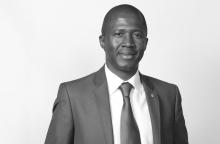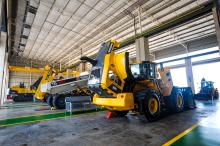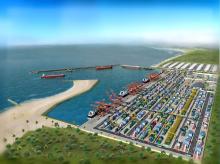
Africa’s reserves of oil and minerals are estimated at over US$55 trillion. And half of the top ten largest, and 20 fastest growing economies in the world are in sub-Saharan Africa, according to Aaron Fosset, CEO of US-based company AFCOM. Patrick Smith reports
Africa is by far the world’s poorest inhabited continent, although parts have made significant gains over the last few years. However, the continent hosts about 30% of the world’s total mineral reserves and an even higher share of deposits of diamonds, vanadium, manganese, platinum, cobalt and gold.
Investors are seeking expansion to new markets especially in the developing world, which presents a new investment frontier for leading mining companies.
In this context, the African mining industry is offering unparalleled opportunities for both local and international investors, says the African Development Bank Group.
“The high cost of mining in developed countries has forced major global companies to seek investment opportunities in Africa which offers relatively low costs of production,” says the bank.
“The opportunity for social and economic transformation through responsible investments in Africa is now,” says Fosset, who was a speaker at a recent event urging investment in the Republic of Guinea. His company specialises in the development, management, financing and structuring of critical infrastructure in sub-Saharan Africa, with the aim of improving the welfare of all stakeholders.
Indeed, such sentiments could apply to other parts of Africa as countries seek to improve their infrastructure. This is proving a major attraction to major aggregates, cement and concrete producers; mineral mining companies, and equipment manufacturers, who combined, are investing billions of dollars.
In Ghana,
Among its first contracts is the supply of two Powerscreen XA400 primary jaw crushers, two 1000
Paul Allman, director-general manager at Hawk Plant said: “We won a contract to manage a number of quarries in Sierra Leone producing aggregates, and crushing equipment was pivotal to the operation.”
Late last year
“Southern Africa is a growing mobile crushing and screening region,” says Nigel Irvine, Terex Finlay’s sales and marketing director.
International equipment services specialist Zero48 has become
Indeed, the rising importance of Africa in the world’s construction and mining markets will take centre stage at the first
Nigeria is also home to Aliko Dangote, the richest man in Africa, whose Dangote group is sub-Saharan Africa’s biggest cement producer.
While in most cases the construction industry is proportional to a country’s gross domestic product, this is not so in the case of Africa, says Louis Santos,
“In Africa the infrastructure business is not related to the GDP growth but to the mining industry where minerals have to be exported. This means that infrastructure, such as roads and ports, has to be built to take the products away,” says Santos.
Out of the 50-plus countries in Africa his company intends to focus on something like 15 because they will show where Metso believes there will be strong development.
Dr Bernd Scheifele, chairman of the managing board of
“In particular the countries of sub-Saharan Africa have a very high growth potential due to their early stage of industrialisation,” says Dr Scheifele. Many other major companies are also targeting such areas, and while the sub-Saharan region shows huge potential, until recently Egypt, Algeria, Morocco, Sudan, Tunisia and Libya were, and indeed may still be, in the top ten largest economies in Africa. North Africa has long been closely linked to the economies of Europe and the Middle East.
Wealthiest state
South Africa is by far the continent’s wealthiest state in total GDP, accounting for some 30% of its GDP in nominal terms and 24% by purchasing power parity (PPP). Nigeria is third; Angola sixth and Ethiopia tenth.
Following the top ten were Kenya, Ghana, Tanzania, Cameroon, Uganda, Cote d’Ivoire, Senegal, Equatorial Guinea, the Democratic Republic of Congo and Gabon.
According to a study by the
In another 2012 report, focusing on the Africa/Middle East region, Freedonia noted that the sales of construction aggregates were 4.1 billion tonnes in 2010, representing 11% of global demand and the second largest regional market worldwide behind Asia/Pacific.
Demand for construction aggregates in the Africa/Mideast region will expand 5.4%/year from 2010-2015 to 5.3 billion tonnes, the second fastest rate of growth behind the Asia/Pacific region but a deceleration from the 2005-2010 pace.
“Intensity of aggregates use compared to GDP and construction spending is well above worldwide averages, reflecting the relatively basic nature of the lion’s share of structures being built, which tend to use greater amounts of concrete,” says Freedonia.
“The most commonly utilised type of aggregate in the Africa/Mideast region is sand, followed by gravel and crushed stone. While demand for other, alternative aggregates has been growing quickly over the past ten years and will continue to grow at a double-digit pace, this segment of the market does not account for a significant portion of overall demand.”
Many of the producers of construction aggregates headquartered in the Africa/Mideast region are small or medium-sized producers, with representative suppliers, says Freedonia, whose detailed reports are available via Corinne Gangloff, Freedonia Group. Tel: +1 440 684 9600; Email: [email protected]; www.freedoniagroup.com).
A number of foreign multi-nationals, including
Investment projects
Indeed, HeidelbergCement says it is currently conducting investment projects in sub-Saharan Africa amounting to almost $400 million They include expansion projects of cement capacity of about 3 million tonnes and of clinker capacity of 1.5 million tonnes.
In Liberia, West Africa, HeidelbergCement recently commissioned its new cement mill at its cement grinding plant in the capital Monrovia, a $14 million investment for an annual capacity of 500,000 tonnes.
The Liberian subsidiary Cemenco is the only cement producer in Liberia and has a strong market position. It is part of HeidelbergCement’s network of cement grinding facilities on the West African coast supporting the group’s regional strategic presence, by setting up adequate capacities to better serve the growing market in important coastal cities.
“The construction of the new cement mill in Liberia is in line with our strategy of modernising and expanding clinker and cement capacities in emerging markets,” says Dr Scheifele.
The economic outlook for Liberia and the sub-Saharan countries is positive. While the
In Ghana, HeidelbergCement has increased the cement grinding capacity at its 1 million tonnes/year Tema cement plant, opened in November 2012 some 25km east of the capital Accra, and is constructing a new 800,000tonnes/year cement mill at its grinding plant in the port city of Takoradi. The $30 million investment also includes the construction of a new clinker and a new cement silo as well as the installation of new cement bag packing and dispatch facilities.
“The construction of the new cement mill in Ghana is another project in the context of our strategy of expanding our clinker and cement capacities in growth markets,” says Dr Scheifele.
Commissioning of the new mill is scheduled for late 2014, and will give HeidelbergCement’s plants in Ghana a total cement capacity of 4.4 million tonnes/year.
South Africa
In South Africa, the Aggregate and Sand Producers Association of Southern Africa (Aspasa), a voluntary producers’ association, helps to improve the quality of aggregates produced by its member companies for construction projects around the country.
Some 130 quarries are represented by Aspasa, whose role is seen as “critical,” considering that almost every structure made by man relies on aggregates for strength and stability (80% of concrete is aggregate and 94% of a road is aggregate).
“Aggregates and sands used in construction projects are naturally occurring minerals that are mined by a specialised sector of the mining industry in South Africa mainly from quarries. Government strictly regulates sand and aggregate quarries due to the importance of obtaining a reliable supply of quality materials.
It also aims to ensure that the minerals and materials are removed in a manner that is sustainable and protects the rights of workers, as well as the environment and surrounding communities,” says Nico Pienaar, director of Aspasa.
“As a private sector association representing producers in the industry, we uphold these aims. In addition we strive to create an economically viable industry with good interaction between all parties involved, from the industry as well as the relevant government departments and other stakeholders.
“Our focus remains largely on creating an environment that is fair and equitable; gives our members space to manoeuvre and to make a good living. On the other hand we expect members to comply with all relevant legislation, as well uphold the strictest standards in quality, health, safety and environmental issues.”
He explains that quarries represented by Aspasa work closely with the government and the Chamber of Mines and are able to provide advice on a wide spectrum of legislation that affects the industry, including input on critical issues surrounding the environment as well as health and safety matters.
These important issues are represented through expert committees with senior and knowledgeable specialists serving to give informed input on all matters. Through these committees, programmes are also able to be developed objectives and improve the overall standards on member mines.
A specialist technical committee also represents the industry on matters that can influence the industry. It works with other industry bodies to ensure that specifications for construction work are up to standard and cost effective. The association also actively promotes the industry as well as the importance of using Aspasa accredited companies.
Indeed, South African cement company PPC (
Meanwhile, the management of Lafarge Cement Wapco Nigeria says the country’s cement market has the potential to be one of the world’s largest.
Managing director Joe Hudson is said to have made the assertion at a customers’ forum where he put the consumption of cement per capita in Nigeria at around 110kg per head (for comparison the DRC currently consumes just 15kg/capita/year and Angola, 300kg/capita/year while the global average is 400kg/capita/year).
He noted that with the population of 160 million, Nigeria has the capacity which could almost triple to about 50 million tonnes per year from its present 20 million tonnes.
Amazing growth
“Nigeria’s cement market is one of the most dynamic markets in the world. We now have local capacity of 20 million tonnes per annum. Nowhere on the planet has there been such an amazing growth,” Hudson is reported as saying.
Nigeria-based Dangote Cement plans to enter the Kenyan market and is said to be seeking to buy a cement company in Kenya.
The move came soon after it started building a cement plant at Mtware in southern Tanzania, which is expected to increase Tanzania’s cement capacity by 1.5 million tonnes by the second quarter of 2015. In furtherance of its Pan-African expansion drive, Dangote Cement laid the foundation stones for the construction of the new $500m cement plant.
“Our investment in this sector, which is outside the traditional mining sector, is to take advantage of the abundance of limestone in the country and work towards making Tanzania self-sufficient in cement production,” says the company in a statement.
Dangote’s entry into the Kenyan market is likely to shake up the market, especially since the country’s production capacity has been running ahead of consumption for over a decade with the excess supply sold in the regional markets.
Bamburi Cement is currently Kenya’s biggest producer with a production capacity of 1.1 million tonnes/year, and other major local producers include ARM Cement and East African Portland Cement Company. (EAPCC).
“Within the next five years we intend to at least double our production capacity, while also looking to increase our market share further still and to expand our business interest into the ready-mixed and pre-cast concrete sectors,” says EAPCC’s managing director, Kephar Tande. This is good news for Kenya where the industry recorded its lowest growth rate for ten years in 2012.
“Going forward the fortunes are expected to turn, as cement demand is projected to expand 10%/year on average and exceed 6.3 million tonnes annually by 2017. Kenya’s cement consumption per capita is also forecast to reach an important milestone in 2014 when it will surpass for the first time in its history 100kg per inhabitant,” says the CW Group, a leading global cement industry consultancy and research house based in New York, USA, as it detailed the state and outlook of the Kenyan market in its 2013
Another cement plant contract has gone to Danish company
With a capacity of 3,000tonnes/day, the scope of FLSmidth’s supply includes plant engineering and all main equipment, including jaw and cone crushers; an Atox raw mill; an OK cement mill; pyroline with cross bar cooler; dosing systems; filters; packing plant, and an automation control system.
Grupo Abayak Akoga Cemento is a newcomer to the cement industry but has been involved in multiple infrastructure projects in Equatorial Guinea.
Cemex says it expects to invest approximately $100 million to significantly improve its operations in Egypt and continue supporting the country’s housing, commercial and infrastructure development. (The planned investments were discussed prior to recent developments in Egypt).
“This investment is expected to support the sustainable development of Egypt for many generations,” says Sergio Menendez, president of Cemex in Egypt. A sizable percentage of the investment will be used by the company to increase its capacity to use coal and pet coke as energy sources in its Assiut cement plant, helping to eliminate fuel subsidies by 2014.
Cemex also expects to invest in equipment to build and promote the construction of concrete roads, and is already planning to support four major concrete paving projects in Egypt during 2013.
PPC expands to East Africa
Pretoria Portland Cement (PPC), a leading cement and aggregate producer in southern Africa, will construct a new $200 million plant in the Democratic Republic of Congo (DRC), the third such investment in the Eastern Africa region by the company, writes Shem Oirere.
PPC, smarting from a decline in sales in Mozambique and Botswana, joins a growing list of construction material producers in Eastern Africa that are taking advantage of the construction boom in the region to grow their share of the market through expansion strategies.
PPC chief executive officer Ketso Gordhan says the DRC investment offers an additional capacity of 1 million tonnes/year and makes PPC the third major cement company to enter the DRC construction materials market after Pakistan’s Lucky Cement and HeidelbergCement.
Lucky Cement, Pakistan’s biggest cement producer, went into a joint venture with Groupe Rawji of DRC for a 1 million tonne cement plant. It also unveiled plans for a $240 million plant in the country with capacity of 1.2 million tonnes/year, more than double the current total production.
Three years ago HeidelbergCement expanded to the DRC when it acquired a 30% stake in Cementerie de Lukala (CILU) and 70% in other plants owned by Belgium’s
PPC, Africa’s third biggest cement maker by value, has already acquired a 27% stake in Ethiopia’s largest cement maker Habesha Cement and a 51% stake in Rwanda’s only cement company, Cimerwa. Part of PPC expansion strategy is to ensure at least 40% of its sales are made outside South Africa by 2016.
“By the last quarter of 2015 we should begin cement production almost simultaneously in Ethiopia, Rwanda and the DRC. Zimbabwe will probably be six to nine months later,” says Gordhan.
PPC, which operates eight cement manufacturing facilities and three millings depots in South Africa, Botswana and Zimbabwe with a total annual production of 8 million tonnes of cement, is making a foray into Eastern Africa as its cement, lime and aggregates segments performance in Mozambique, Zimbabwe and Botswana has weakened on the back of falling demand and the sluggish construction industry.
The management of PPC says despite aggregates performance having been in line with its 2012 projections, there was a decline both in South Africa and Botswana.
“This encouraging trend was, however, tempered by weakness in cement sales in Botswana as well as lower demand in the lime and aggregates divisions,” says PPC in its half-year performance report.
In southern Africa, PPC Aggregates, PPC’s largest division, expanded its total capacity to 4 million tonnes, up from 3 million tonnes after acquiring three more quarries in Botswana for $6.8 million, making the company the largest aggregate producer in that country.
Earlier, PPC jointly acquired 47% of Ethiopia’s Habesha Cement, based near the capital, Addis Ababa, with South Africa’s Industrial Development Corporation (IDC).
Habesha Cement, taking advantage of the construction boom in Ethiopia, plans a $130 million plant expansion to increase its capacity by an additional 1.4 million tonnes/year by 2014, with the option of increasing production to 2.8 million tonnes/year. Although construction of the Habesha cement plant in Ethiopia has been delayed, PPC says construction will start in October 2013.
Habesha produces ready-mix concrete, Portland pozzolana cement, cement bags and ordinary Portland cement.
PPC’s interest in Eastern Africa also includes the acquisition of a controlling 51% stake in Rwanda’s sole cement maker Cimerwa, which currently has a capacity of 100,000tonnes/year. The plant’s capacity is being expanded to 600,000tonnes/year with a completion date of 2014.
The cement maker is riding on increased sales and good pricing of cement in South Africa and Zimbabwe, which pushed its total earnings up by 8% to $386 million (ZAR 3,812 million) compared to $357 million (ZAR 3,529 million) for the same period in 2012.
PPC’s growing interest in East Africa’s construction materials market coincides with an anticipated growth of the region’s construction industry underpinned by huge infrastructure projects that are either undergoing or in the pipeline.
Business Monitor International, for example, says in one market research report that governments in East Africa will shift focus to the elimination of urban slums, which is expected to be a major driver of the region’s construction industry.
PPC says it is “in the feasibility phase of further projects involving two other countries and we are confident that further progress on this strategy will be made in the second half of the year.”









